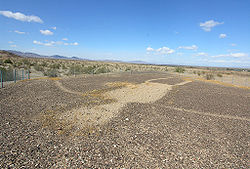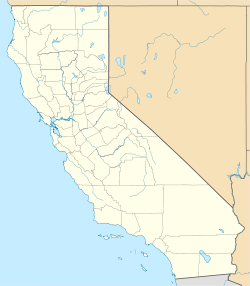Native American Stone Art That Can Only Be Seen From the Sky
| Blythe Intaglios | |
| U.S. National Register of Historic Places | |
| California Historical LandmarkNo. 101 | |
 One of the Blythe Intaglios, 2007 | |
| Location in California Show map of California Blythe Intaglios (the United States) Prove map of the United States | |
| Nearest city | Blythe, California |
|---|---|
| Coordinates | 33°48′01″N 114°32′18″W / 33.80028°North 114.53833°W / 33.80028; -114.53833 Coordinates: 33°48′01″N 114°32′18″W / 33.80028°N 114.53833°Due west / 33.80028; -114.53833 |
| NRHP referenceNo. | 75000452 |
| CHISLNo. | 101 |
| Added to NRHP | August 22, 1975 |
The Blythe Intaglios or Blythe Geoglyphs are a group of gigantic figures incised on the ground near Blythe, California, in the Colorado Desert. The basis drawings or geoglyphs were created past humans for an, as yet, unknown reason.
The intaglios are located east of the Big Maria Mountains, about xv miles (24 km) north of downtown Blythe, just w of U.S. Highway 95 near the Colorado River. The Blythe Intaglios are the most well-known of the over 200 intaglios in the Colorado Desert.[one] The Colorado Desert contains the merely known desert intaglios in N America.[1] These intaglios are more often than not located forth the Colorado River.
The Blythe Intaglios incorporate 3 human figures, two four-legged animals, and a spiral; although Harner (1953) reported two spirals.[ii] The largest human figure in the Blythe Intaglio group is 171 feet (52 m) long. The intaglios are best viewed from the air.
Geoglyphs are found throughout the world, the construction methods range from earthen mounds, piles of stone, or the removal of surface plants or soil. The most famous desert intaglios are the Nazca Lines in Peru.[three] The Blythe Geoglyphs or intaglios (anthropomorphic geoglyphs) were created past scraping abroad layers of darker rocks or pebbles to reveal a stratum of lighter-valued soil. The displaced rocks outlined the figures and the exposed soil was stamped down which makes it more difficult for plants to abound in the lines. The intaglios are located on flat terraces in the Colorado River floodplain.[2]
While these "gravel pictographs" are found through the deserts of southeastern California, human figures are found only nearly the Colorado River. Other intaglios depict mountain lions, birds, snakes and unidentified zoomorphic and geometric shapes.[i] The figures are so immense that many of them were non observed past non-natives until the 1930s.[4] The prepare of Blythe Intaglios and nearby geoglyphs include several dozen figures, thought to be ceremonial in nature.[5]
No Colorado River Native American grouping has claimed to take fabricated the intaglios, although some have claimed to utilise them.[2] Many of the intaglios are believed to engagement from the prehistoric menses, but their age and the identity of their creators are notwithstanding uncertain. If the quadruped figures represent horses (reintroduced in North America past the Spanish) and so a historical date would be supported.[2] Jay von Werlhof and his collaborators obtained thirteen AMS radiocarbon dates for the figures, ranging from 900 BCE to 1200 CE.[vi]

Blythe Intaglios – Brute and Spirit Figures, October 2016

Blythe Intaglios – Human Effigy 1, October 2016

Blythe Intaglios – Human Effigy 2, October 2016
Rediscovery [edit]
In 1932, George Palmer, a pilot flight betwixt Las Vegas, Nevada and Blythe, California noticed the Blythe geoglyphs.[7] His find led to a survey of the area in the same twelvemonth by Arthur Woodward, Curator of History and Anthropology at the Natural History Museum of Los Angeles Canton.[8] Malcolm J. Rogers subsequently studied and sketched the Blythe Intaglios in 1939.[2] After National Geographic published an commodity nigh the Blythe Intaglios in 1952, people began to visit the site which led to some destruction of the intaglios.[1]
The involvement in the Blythe intaglios led to the search for and discovery of more than desert intaglios. The Bureau of State Management erected fences in 1974 to protect the intaglios and the Blythe Intaglios were placed on the National Register of Historic Places in 1982.
Like intaglios, named the Ripley Group, were found nearby in Arizona across the Colorado River from Ripley, California.[2]
Topock Maze [edit]
The Topock Maze or Mojave Maze, some other geoglyph site near Needles, California, covers 18 acres (73,000 mii) and consists of a series of parallel windrows approximately five anxiety (1.5 thousand) apart.[seven] However, information technology is unclear whether the Topock Maze was created by Native Americans.
Edward Curtis reported in 1908 that, "The Mohave Indians near past have utilized the area ... in recent years, as a maze into which to lure and escape evil spirits, for it is believed that past running in and out through one of these immense labyrinths, one haunted with a dread may bewilder the spirit occasioning information technology, and thus elude them."[ix] Similarly, an unpublished mid-20th century report cited second-manus ethnographic data that, prior to 1900, the "Mohave used to put some of their men in the center of the area of alignment and left them to discover their manner out of the maze without crossing the gravel alignments. Past doing this they would leave the devil behind them."[10]
However, Ruth Musser-Lopez reviewed historic and archaeological evidence concerning the "maze" and found strong back up for the conjecture that the feature was originally created every bit a result of belatedly nineteenth-century gravel harvesting for railroad construction and thus unrelated to the Blythe geoglyphs.[11] For instance, old foot trails exist in undisturbed ground and stop at, but practice not cross, the lines of gravel indicating that the gravel is more contempo than the trails. The Mojave people have denied knowing the origin of the Topock Maze.[12]
Figures [edit]
Patterns and circles at the site advise that local groups may take danced there.[1] Trails pb to the intaglios and rock alignments and rock cairns are often near the intaglios.[1] Ethnographer Boma Johnson has tried to place the figures in context of Yuman oral history and cosmology.[7] From this understanding, the figures portray mythic characters, and are oft constitute where mythic events are thought to have occurred.[7] 1 of the notable mythic figures is a 65-to-fourscore-foot-long (20 to 25 m) humanoid figure located next to a 2nd glyph, this of a quadruped resembling a mountain king of beasts.[7] Additionally, 18-human foot-alpine (5.5 one thousand) figures begetting a likeness to Mastamho and Kataar, the "hero twins of the creation myth," can exist seen most Fort Mojave in Arizona.
Some researchers hypothesize that the intaglios are stopping points on a keruk pilgrimage or but the practice of the keruk ceremony at diverse places.[13] The keruk was a mourning ceremony that was adept by various Native Americans in southern California. The keruk included the re-enactment of the creator's death and the recognition of the people who had died since the last keruk. Warfare has been offered a possible explanation as to the spread along the Colorado River of ceremonies such as the keruk and the similar style of desert intaglios.[13]
Of the nearly sixty sites containing humanoid figures, well-nigh all of them have a securely entrenched trunk, while the limbs are much more shallowly etched into the surface. Often, the caput and/or i or more than artillery of the figure will not have been represented at all.[7] The largest human figure is 171 feet (52 thou) long, while the smallest is 95 feet (29 one thousand) long.[10]
Location [edit]
The majority of the Blythe geoglyphs are located 16 miles (26 km) north of Blythe, California, off Highway 95, at the Interstate 10 exit and down several dirt roads for 15.five miles (24.9 km). An historical marker (No. 101) placed by the California Section of Public Works, Division of Highways, commemorates the site.[14] Chain link fences environs several of the figures.[15]
In pop culture [edit]
The intaglios were featured prominently in the Hardy Boys novel Mystery of the Desert Giant, published in 1961.
See likewise [edit]
- Nazca lines
- Hill figure
- California Historical Landmarks in Riverside County, California
Notes [edit]
- ^ a b c d e f Leska, Amy (2008). "A cursory introduction to the intaglios of the Mojave Desert". Trough to Trough: 125–26.
- ^ a b c d e f Harner, Michael (1953). "21. Gravel Pictographs of the Lower Colorado River Region".
- ^ Maillard, Frederico (2009). "Geoglyphs on the Har Karkom Plateau (Negev, Israel)". Papers, XXIII Valcamonica Symposium 2009: 208–14.
- ^ Gilreath, p. 288
- ^ Gilreath, pp. 288–89
- ^ von Werlhof et al. 1995.
- ^ a b c d e f Gilreath, p. 289
- ^ Welfare and Fairley, p. 117
- ^ Curtis, p. 55.
- ^ a b Gilreath, p. 289.
- ^ Musser-Lopez 2011.
- ^ Musser-Lopez, Ruth (2011). ""Mystic Maze" or "Mystic Maize": The Amazing Archaeological Evidence". Proceedings of the Society for California Archæology.
- ^ a b Altschul & Ezzo (1995). "Ceremony and Warfare along the Lower Colorado River during the Protohistoric Period". Proceedings of the Society for California Archaeology: 133–45.
- ^ Johnson, Marael (1995). Why Cease? A Guide to California Roadside Historical Markers. Houston, TX: Gulf Publishing Company. p. 21. ISBN9780884159230. OCLC 32168093.
- ^ Olsen, p. 99
References [edit]
- Altschul, Jeffrey H., and Joseph A. Ezzo. 1995 Ceremony and Warfare along the Lower Colorado River during the Protohistoric Period. Proceedings of the Order for California Archæology 8: 133–45.
- Curtis, Edward S. Indians of North America, vol. ii Norwood, Massachusetts: Plimpton Printing.
- Gilreath, Amy J. California Prehistory: Rock Art in the Golden State. In Colonization, Culture, and Complication, edited by Terry L. Jones and Kathryn A. Klar, pp. 273–ninety. Lanham, Physician: Rowman Altamira, 2007. ISBN 978-0-7591-1960-4.
- Harner, Michael J. 1953 21. Gravel Pictographs of the Lower Colorado River Region.
- Leska, Amy. 2008 A brief introduction to the intaglios of the Mojave Desert. Trough to trough: 125–26.
- Maillard, Federico. 2009 Geoglyphs on the Har Karkom Plateau (Negev, Israel). Papers, XXIII Valcamonica Symposium 2009: 208–14.
- Musser-Lopez, Ruth Arlene. 2001 "Mystic Maze" or "Mystic Maize": The Astonishing Archaeological Evidence. Proceedings of the Gild for California Archaeology 25.
- Olsen, Brad. Sacred Places North America: 108 Destinations. CCC Publishing, 2008. ISBN 978-1-888729-13-ix.
- von Werlhof, Jay, Harry Casey, Ronald I. Dorn, and Glenn A. Jones. AMS fourteenC Age Constraints on Geoglyphs in the Lower Colorado River Region, Arizona and California. Geoarchaeology: An International Journal 10:257–73. 1995.
- Welfare, Simon and Fairley, John. Arthur C. Clarke's Mysterious Globe. San Francisco: HarperCollins, 1985. ISBN 978-0-00-217424-four.
External links [edit]
- Blythe Intaglios, photo gallery, James Q. Jacobs
- Recreation.gov
- Bureau of State Management-Arizona Office
Source: https://en.wikipedia.org/wiki/Blythe_Intaglios


Post a Comment for "Native American Stone Art That Can Only Be Seen From the Sky"